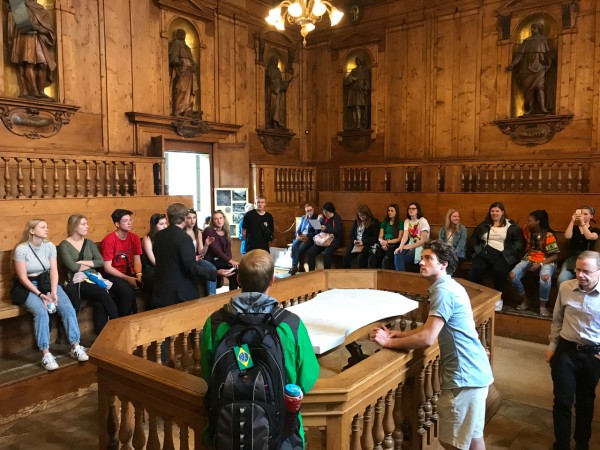Seeing Study Abroad From New Angles With 360 Video

You’re taking a tour of an Italian city. As the guide leads you through a building and explains its history, you look up to the ceiling and marvel at the artistry of the architecture. But you’re not in Italy. You’re at home, comfortably seated on the couch using your iPad as a gateway to a place halfway across the world.
Thanks to 360-degree video, a technology that makes it possible for viewers to see what is happening in every direction, anyone can join the Department of French and Italian’s study abroad trip to Bologna, Italy.
“As you interact with the video, you are in Bologna with us,” said Erik Scaltriti, a graduate teaching associate and doctoral candidate in the department.
Scaltriti, who also specializes in inclusive pedagogical practices, spent a semester working with Digital Flagship on analysis of their programming, which he said got him interested in how interactive tools could change language education. Drawing on his filmmaking background, he saw 360-degree video as a unique way to document the May 2019 trip.
The video takes you from classrooms to historical sites, cafes and parks as Scaltriti and his students capture footage on the 360-degree camera. The result is an immersive narrative of the trip told through short clips you can explore on an iPad. Turn your device in any direction to reveal more of each shot, taking in the sights and sounds of Italy the same way the students did.
Scaltriti explained that the 360-degree video is a more “democratic” experience than traditional video or even still images because it allows the viewer some control over their experience. You can choose to focus on what the group is looking at (say, a tour guide or a server at a café) or aim your iPad in another direction to find a piece of art or menu board that catches your eye.
Students present on the trip have expressed to Scaltriti that this video not only helps them relive their memories of the trip, it also made it easy to share their experiences with friends and family.
“It instantly takes me back to our short month we had together and perfectly summarizes our experience for participants in the future,” said student Nick Tomasetti.
Scaltriti debuted the video at a study abroad expo in September, so prospective attendees could get a unique glimpse into the trip, traveling along before they even made the decision to sign up.
Scaltriti sees this as the first step to a more immersive experience in language classes. Senior Lecturer April Weintritt and Professor Janice Aski are developing a course for the department that will incorporate 360-video in giving students an “on the ground” experience of Italian language and culture before travels abroad.
The process is greatly streamlined by Digital Flagship. With a common device available to students, Scaltriti said, educators have a starting point for integrating technology into their curriculum.
He envisions students in the near future accessing 360-degree videos on their iPads to practice their skills in the middle of a busy market or learn how to buy a train ticket in another country. Scaltriti thinks this type of educational enhancement could travel beyond his department to other disciplines, changing the way students experience courses in architecture, art history and more.
“Instead of this passive screen experience,” Scaltriti said, “it can be something more challenging.”
Watch the 360-degree video and learn more about the upcoming May 2020 study abroad trip on the Department of French and Italian’s website.
Interested in how Digital Flagship is changing the way Buckeyes teach and learn? Sign up to hear more about educator opportunities.
